Critical Thinking and Problem Solving: Strategic Thinking Report
VerifiedAdded on 2023/05/28
|5
|1361
|345
Report
AI Summary
This report delves into the concept of strategic thinking, defining it as a process of generating and applying business visions to achieve competitive advantages. The report emphasizes the significance of strategic thinking in fostering purpose clarity and effective leadership across various domains including business, education, and health. It explores the application of strategic thinking by examining the interplay of feeling, thinking, and wanting, and illustrates how identifying and modifying irrational thinking can lead to more rational decision-making. The report also outlines the key ideas of strategic thinking, including the six P's (Plan, Ploy, Pattern, Purpose, Position, and Push) and other crucial elements like anticipation, interpretation, and decision-making. Furthermore, it develops a practical strategy for action in a competitive workplace scenario, providing a framework for addressing irrational thinking and emotions. The report concludes by highlighting the importance of strategic thinking in both personal and professional life, underscoring its role in effective problem-solving and leadership.
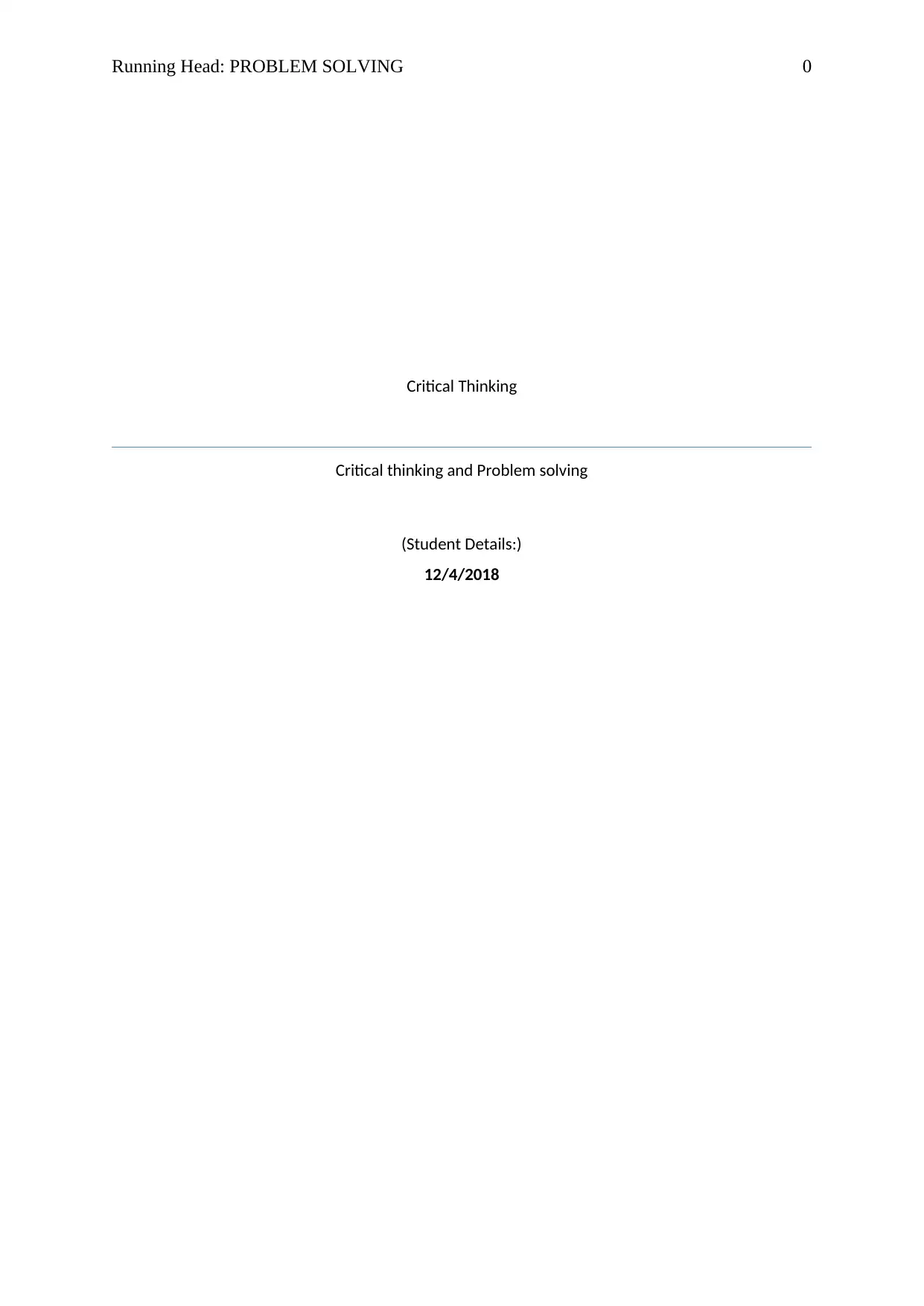
Running Head: PROBLEM SOLVING 0
Critical Thinking
Critical thinking and Problem solving
(Student Details:)
12/4/2018
Critical Thinking
Critical thinking and Problem solving
(Student Details:)
12/4/2018
Paraphrase This Document
Need a fresh take? Get an instant paraphrase of this document with our AI Paraphraser
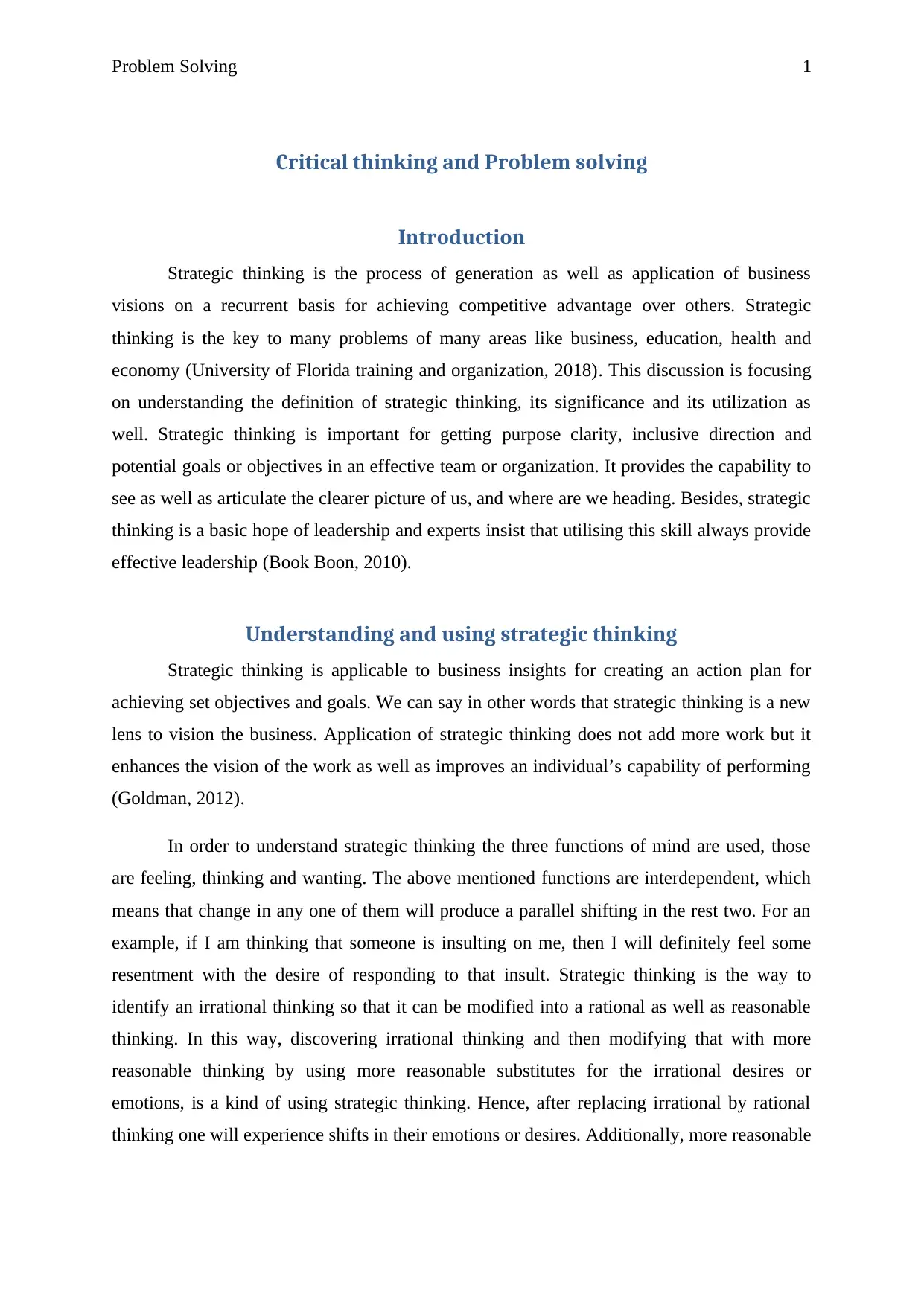
Problem Solving 1
Critical thinking and Problem solving
Introduction
Strategic thinking is the process of generation as well as application of business
visions on a recurrent basis for achieving competitive advantage over others. Strategic
thinking is the key to many problems of many areas like business, education, health and
economy (University of Florida training and organization, 2018). This discussion is focusing
on understanding the definition of strategic thinking, its significance and its utilization as
well. Strategic thinking is important for getting purpose clarity, inclusive direction and
potential goals or objectives in an effective team or organization. It provides the capability to
see as well as articulate the clearer picture of us, and where are we heading. Besides, strategic
thinking is a basic hope of leadership and experts insist that utilising this skill always provide
effective leadership (Book Boon, 2010).
Understanding and using strategic thinking
Strategic thinking is applicable to business insights for creating an action plan for
achieving set objectives and goals. We can say in other words that strategic thinking is a new
lens to vision the business. Application of strategic thinking does not add more work but it
enhances the vision of the work as well as improves an individual’s capability of performing
(Goldman, 2012).
In order to understand strategic thinking the three functions of mind are used, those
are feeling, thinking and wanting. The above mentioned functions are interdependent, which
means that change in any one of them will produce a parallel shifting in the rest two. For an
example, if I am thinking that someone is insulting on me, then I will definitely feel some
resentment with the desire of responding to that insult. Strategic thinking is the way to
identify an irrational thinking so that it can be modified into a rational as well as reasonable
thinking. In this way, discovering irrational thinking and then modifying that with more
reasonable thinking by using more reasonable substitutes for the irrational desires or
emotions, is a kind of using strategic thinking. Hence, after replacing irrational by rational
thinking one will experience shifts in their emotions or desires. Additionally, more reasonable
Critical thinking and Problem solving
Introduction
Strategic thinking is the process of generation as well as application of business
visions on a recurrent basis for achieving competitive advantage over others. Strategic
thinking is the key to many problems of many areas like business, education, health and
economy (University of Florida training and organization, 2018). This discussion is focusing
on understanding the definition of strategic thinking, its significance and its utilization as
well. Strategic thinking is important for getting purpose clarity, inclusive direction and
potential goals or objectives in an effective team or organization. It provides the capability to
see as well as articulate the clearer picture of us, and where are we heading. Besides, strategic
thinking is a basic hope of leadership and experts insist that utilising this skill always provide
effective leadership (Book Boon, 2010).
Understanding and using strategic thinking
Strategic thinking is applicable to business insights for creating an action plan for
achieving set objectives and goals. We can say in other words that strategic thinking is a new
lens to vision the business. Application of strategic thinking does not add more work but it
enhances the vision of the work as well as improves an individual’s capability of performing
(Goldman, 2012).
In order to understand strategic thinking the three functions of mind are used, those
are feeling, thinking and wanting. The above mentioned functions are interdependent, which
means that change in any one of them will produce a parallel shifting in the rest two. For an
example, if I am thinking that someone is insulting on me, then I will definitely feel some
resentment with the desire of responding to that insult. Strategic thinking is the way to
identify an irrational thinking so that it can be modified into a rational as well as reasonable
thinking. In this way, discovering irrational thinking and then modifying that with more
reasonable thinking by using more reasonable substitutes for the irrational desires or
emotions, is a kind of using strategic thinking. Hence, after replacing irrational by rational
thinking one will experience shifts in their emotions or desires. Additionally, more reasonable
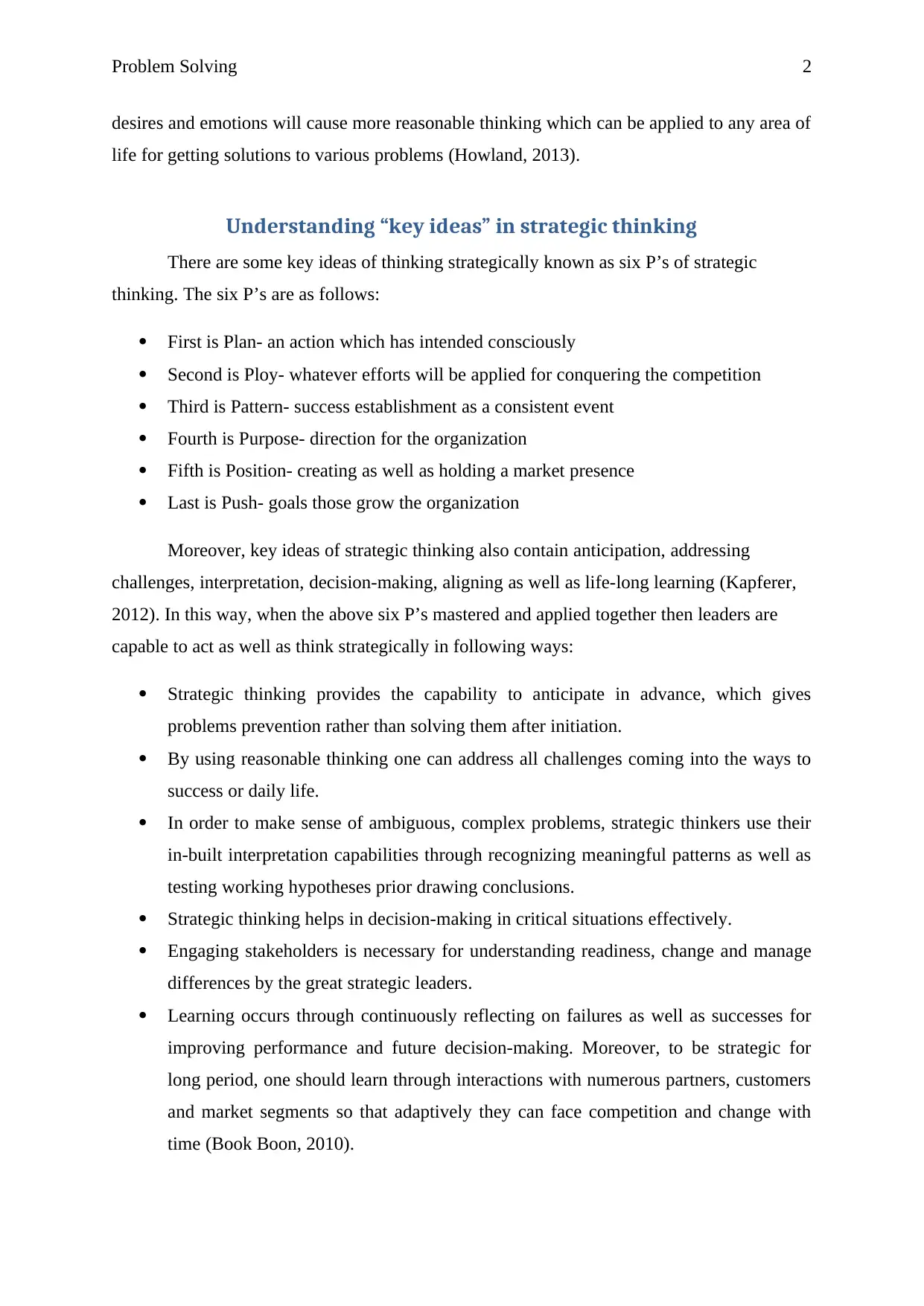
Problem Solving 2
desires and emotions will cause more reasonable thinking which can be applied to any area of
life for getting solutions to various problems (Howland, 2013).
Understanding “key ideas” in strategic thinking
There are some key ideas of thinking strategically known as six P’s of strategic
thinking. The six P’s are as follows:
First is Plan- an action which has intended consciously
Second is Ploy- whatever efforts will be applied for conquering the competition
Third is Pattern- success establishment as a consistent event
Fourth is Purpose- direction for the organization
Fifth is Position- creating as well as holding a market presence
Last is Push- goals those grow the organization
Moreover, key ideas of strategic thinking also contain anticipation, addressing
challenges, interpretation, decision-making, aligning as well as life-long learning (Kapferer,
2012). In this way, when the above six P’s mastered and applied together then leaders are
capable to act as well as think strategically in following ways:
Strategic thinking provides the capability to anticipate in advance, which gives
problems prevention rather than solving them after initiation.
By using reasonable thinking one can address all challenges coming into the ways to
success or daily life.
In order to make sense of ambiguous, complex problems, strategic thinkers use their
in-built interpretation capabilities through recognizing meaningful patterns as well as
testing working hypotheses prior drawing conclusions.
Strategic thinking helps in decision-making in critical situations effectively.
Engaging stakeholders is necessary for understanding readiness, change and manage
differences by the great strategic leaders.
Learning occurs through continuously reflecting on failures as well as successes for
improving performance and future decision-making. Moreover, to be strategic for
long period, one should learn through interactions with numerous partners, customers
and market segments so that adaptively they can face competition and change with
time (Book Boon, 2010).
desires and emotions will cause more reasonable thinking which can be applied to any area of
life for getting solutions to various problems (Howland, 2013).
Understanding “key ideas” in strategic thinking
There are some key ideas of thinking strategically known as six P’s of strategic
thinking. The six P’s are as follows:
First is Plan- an action which has intended consciously
Second is Ploy- whatever efforts will be applied for conquering the competition
Third is Pattern- success establishment as a consistent event
Fourth is Purpose- direction for the organization
Fifth is Position- creating as well as holding a market presence
Last is Push- goals those grow the organization
Moreover, key ideas of strategic thinking also contain anticipation, addressing
challenges, interpretation, decision-making, aligning as well as life-long learning (Kapferer,
2012). In this way, when the above six P’s mastered and applied together then leaders are
capable to act as well as think strategically in following ways:
Strategic thinking provides the capability to anticipate in advance, which gives
problems prevention rather than solving them after initiation.
By using reasonable thinking one can address all challenges coming into the ways to
success or daily life.
In order to make sense of ambiguous, complex problems, strategic thinkers use their
in-built interpretation capabilities through recognizing meaningful patterns as well as
testing working hypotheses prior drawing conclusions.
Strategic thinking helps in decision-making in critical situations effectively.
Engaging stakeholders is necessary for understanding readiness, change and manage
differences by the great strategic leaders.
Learning occurs through continuously reflecting on failures as well as successes for
improving performance and future decision-making. Moreover, to be strategic for
long period, one should learn through interactions with numerous partners, customers
and market segments so that adaptively they can face competition and change with
time (Book Boon, 2010).
⊘ This is a preview!⊘
Do you want full access?
Subscribe today to unlock all pages.

Trusted by 1+ million students worldwide
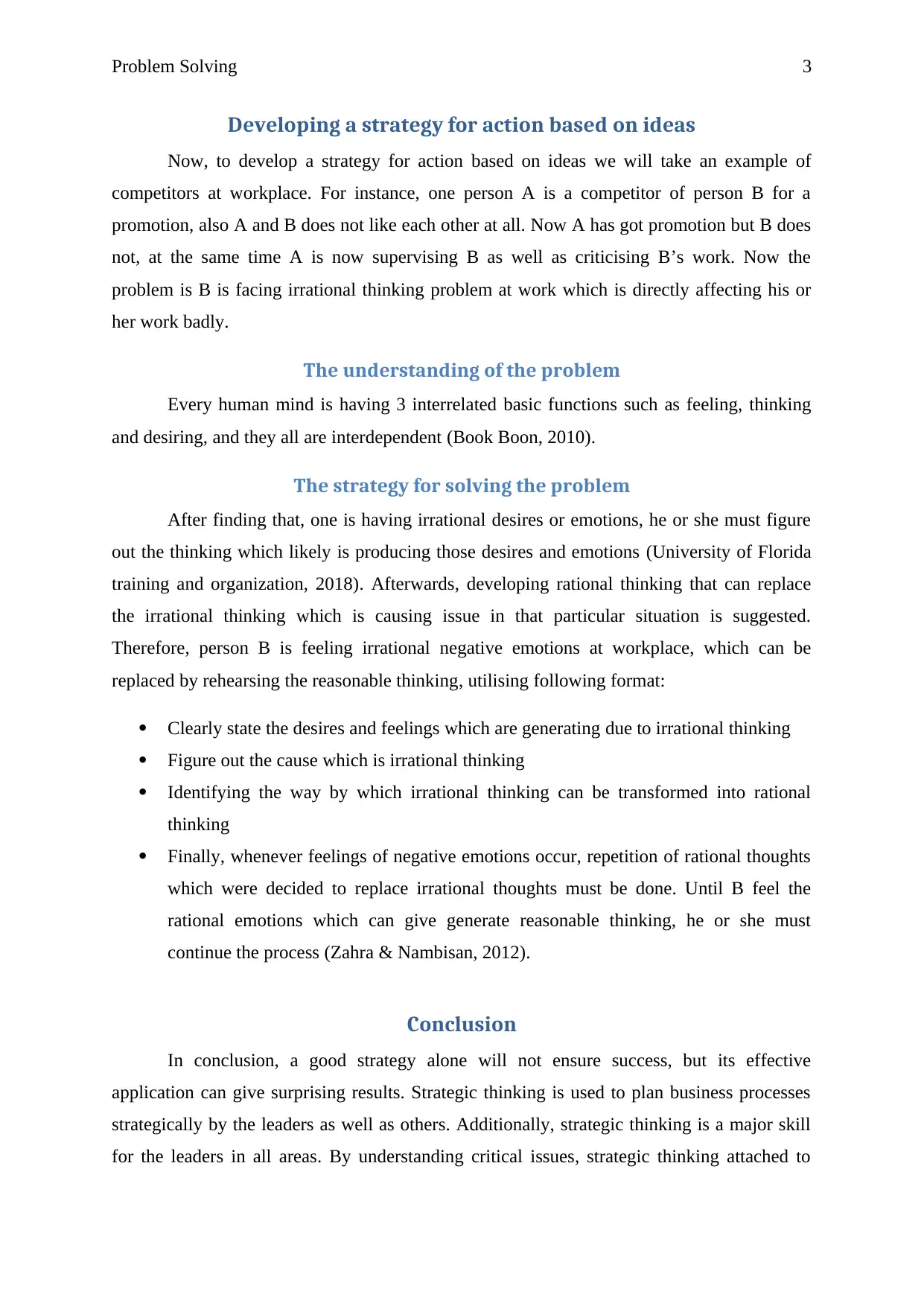
Problem Solving 3
Developing a strategy for action based on ideas
Now, to develop a strategy for action based on ideas we will take an example of
competitors at workplace. For instance, one person A is a competitor of person B for a
promotion, also A and B does not like each other at all. Now A has got promotion but B does
not, at the same time A is now supervising B as well as criticising B’s work. Now the
problem is B is facing irrational thinking problem at work which is directly affecting his or
her work badly.
The understanding of the problem
Every human mind is having 3 interrelated basic functions such as feeling, thinking
and desiring, and they all are interdependent (Book Boon, 2010).
The strategy for solving the problem
After finding that, one is having irrational desires or emotions, he or she must figure
out the thinking which likely is producing those desires and emotions (University of Florida
training and organization, 2018). Afterwards, developing rational thinking that can replace
the irrational thinking which is causing issue in that particular situation is suggested.
Therefore, person B is feeling irrational negative emotions at workplace, which can be
replaced by rehearsing the reasonable thinking, utilising following format:
Clearly state the desires and feelings which are generating due to irrational thinking
Figure out the cause which is irrational thinking
Identifying the way by which irrational thinking can be transformed into rational
thinking
Finally, whenever feelings of negative emotions occur, repetition of rational thoughts
which were decided to replace irrational thoughts must be done. Until B feel the
rational emotions which can give generate reasonable thinking, he or she must
continue the process (Zahra & Nambisan, 2012).
Conclusion
In conclusion, a good strategy alone will not ensure success, but its effective
application can give surprising results. Strategic thinking is used to plan business processes
strategically by the leaders as well as others. Additionally, strategic thinking is a major skill
for the leaders in all areas. By understanding critical issues, strategic thinking attached to
Developing a strategy for action based on ideas
Now, to develop a strategy for action based on ideas we will take an example of
competitors at workplace. For instance, one person A is a competitor of person B for a
promotion, also A and B does not like each other at all. Now A has got promotion but B does
not, at the same time A is now supervising B as well as criticising B’s work. Now the
problem is B is facing irrational thinking problem at work which is directly affecting his or
her work badly.
The understanding of the problem
Every human mind is having 3 interrelated basic functions such as feeling, thinking
and desiring, and they all are interdependent (Book Boon, 2010).
The strategy for solving the problem
After finding that, one is having irrational desires or emotions, he or she must figure
out the thinking which likely is producing those desires and emotions (University of Florida
training and organization, 2018). Afterwards, developing rational thinking that can replace
the irrational thinking which is causing issue in that particular situation is suggested.
Therefore, person B is feeling irrational negative emotions at workplace, which can be
replaced by rehearsing the reasonable thinking, utilising following format:
Clearly state the desires and feelings which are generating due to irrational thinking
Figure out the cause which is irrational thinking
Identifying the way by which irrational thinking can be transformed into rational
thinking
Finally, whenever feelings of negative emotions occur, repetition of rational thoughts
which were decided to replace irrational thoughts must be done. Until B feel the
rational emotions which can give generate reasonable thinking, he or she must
continue the process (Zahra & Nambisan, 2012).
Conclusion
In conclusion, a good strategy alone will not ensure success, but its effective
application can give surprising results. Strategic thinking is used to plan business processes
strategically by the leaders as well as others. Additionally, strategic thinking is a major skill
for the leaders in all areas. By understanding critical issues, strategic thinking attached to
Paraphrase This Document
Need a fresh take? Get an instant paraphrase of this document with our AI Paraphraser
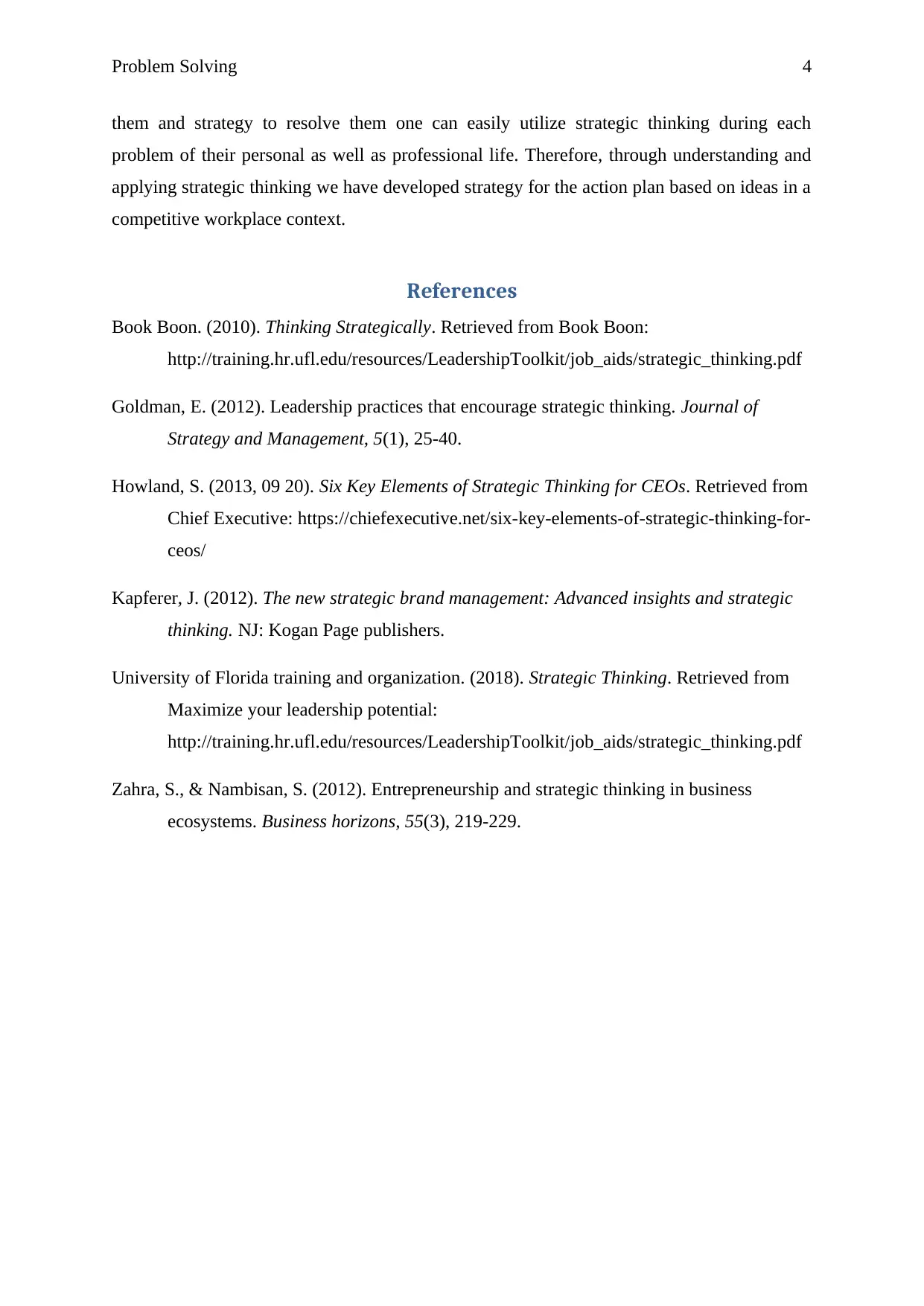
Problem Solving 4
them and strategy to resolve them one can easily utilize strategic thinking during each
problem of their personal as well as professional life. Therefore, through understanding and
applying strategic thinking we have developed strategy for the action plan based on ideas in a
competitive workplace context.
References
Book Boon. (2010). Thinking Strategically. Retrieved from Book Boon:
http://training.hr.ufl.edu/resources/LeadershipToolkit/job_aids/strategic_thinking.pdf
Goldman, E. (2012). Leadership practices that encourage strategic thinking. Journal of
Strategy and Management, 5(1), 25-40.
Howland, S. (2013, 09 20). Six Key Elements of Strategic Thinking for CEOs. Retrieved from
Chief Executive: https://chiefexecutive.net/six-key-elements-of-strategic-thinking-for-
ceos/
Kapferer, J. (2012). The new strategic brand management: Advanced insights and strategic
thinking. NJ: Kogan Page publishers.
University of Florida training and organization. (2018). Strategic Thinking. Retrieved from
Maximize your leadership potential:
http://training.hr.ufl.edu/resources/LeadershipToolkit/job_aids/strategic_thinking.pdf
Zahra, S., & Nambisan, S. (2012). Entrepreneurship and strategic thinking in business
ecosystems. Business horizons, 55(3), 219-229.
them and strategy to resolve them one can easily utilize strategic thinking during each
problem of their personal as well as professional life. Therefore, through understanding and
applying strategic thinking we have developed strategy for the action plan based on ideas in a
competitive workplace context.
References
Book Boon. (2010). Thinking Strategically. Retrieved from Book Boon:
http://training.hr.ufl.edu/resources/LeadershipToolkit/job_aids/strategic_thinking.pdf
Goldman, E. (2012). Leadership practices that encourage strategic thinking. Journal of
Strategy and Management, 5(1), 25-40.
Howland, S. (2013, 09 20). Six Key Elements of Strategic Thinking for CEOs. Retrieved from
Chief Executive: https://chiefexecutive.net/six-key-elements-of-strategic-thinking-for-
ceos/
Kapferer, J. (2012). The new strategic brand management: Advanced insights and strategic
thinking. NJ: Kogan Page publishers.
University of Florida training and organization. (2018). Strategic Thinking. Retrieved from
Maximize your leadership potential:
http://training.hr.ufl.edu/resources/LeadershipToolkit/job_aids/strategic_thinking.pdf
Zahra, S., & Nambisan, S. (2012). Entrepreneurship and strategic thinking in business
ecosystems. Business horizons, 55(3), 219-229.
1 out of 5
Related Documents
Your All-in-One AI-Powered Toolkit for Academic Success.
+13062052269
info@desklib.com
Available 24*7 on WhatsApp / Email
![[object Object]](/_next/static/media/star-bottom.7253800d.svg)
Unlock your academic potential
Copyright © 2020–2025 A2Z Services. All Rights Reserved. Developed and managed by ZUCOL.




